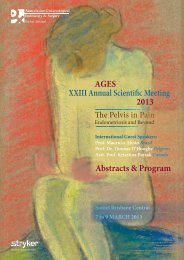to Obstetric Trauma Pelvic Floor Repair Surgical Essentials - AGES
to Obstetric Trauma Pelvic Floor Repair Surgical Essentials - AGES
to Obstetric Trauma Pelvic Floor Repair Surgical Essentials - AGES
You also want an ePaper? Increase the reach of your titles
YUMPU automatically turns print PDFs into web optimized ePapers that Google loves.
Program<br />
Abstracts<br />
Friday<br />
3 June<br />
Session 3 / 1330-1350<br />
Laparoscopic mesh sacrohysteropexy<br />
Lam A<br />
Hysterec<strong>to</strong>my is traditionally considered an essential part of the<br />
surgical treatment for significant utero-vaginal prolapse. This is most<br />
often performed as a vaginal or abdominal procedure, accompanied<br />
by some form of level I vault suspension , and where indicated level<br />
II or III colporrhaphy. While sacrocolpopepxy has been found <strong>to</strong> be<br />
superior <strong>to</strong> vaginal sacrospinous colpopexy, there is insufficient<br />
evidence <strong>to</strong> support or refute the traditional view that hysterec<strong>to</strong>my<br />
is integral <strong>to</strong> successful surgical management of significant uterovaginal<br />
prolapse.<br />
At CARE, we have adopted a ‘conservative’ approach on the basis<br />
that:<br />
• Sacrocolpopexy is associated with a lower rate of vault recurrence<br />
and dyspareunia than sacrospinous colpopexy.<br />
• Uterine preservation and hence hysteropexy is associated with<br />
a lower rate of mesh-related complications, in particular a lower<br />
risk of mesh erosion and infection.<br />
• Laparoscopic sacrocolpopexy is equally successful and is<br />
less invasive than abdominal sacrocolpopexy in the hands of<br />
experienced surgeons.<br />
• Laparoscopic mesh sacrohysteropexy, in the presence of a<br />
normal size uterus, is a reasonable and logical alternative <strong>to</strong><br />
hysterec<strong>to</strong>my and sacrocolpopexy in the surgical management of<br />
significant utero-vaginal prolapse.<br />
In this presentation, the author will:<br />
• Review the evidence in the literature<br />
• Present the surgical technique(s) of laparoscopic mesh<br />
sacrohysterpexy<br />
• Evaluate the results of sacrocolpopexy since 2004 from CARE<br />
prospective data base<br />
• Compare laparoscopic and vaginal mesh hysteropexy results<br />
• Draw conclusions <strong>to</strong> help guide clinical practice in the surgical<br />
management of significant utero-vaginal prolapse.<br />
AUTHOR AFFILIATION: Assoc. Prof. Alan Lam, Centre for Advanced<br />
Reproductive Endosurgery (CARE), St Leonards, NSW, Australia.<br />
Session 3 / 1350-1410<br />
Laparoscopic suture hysteropexy<br />
– a simple technique for uterine<br />
preservation<br />
Seman E, Bedford N<br />
Laparoscopic uterosacral hysteropexy is the most popular procedure<br />
recommended by Australian & New Zealand gynaecologists <strong>to</strong><br />
women undergoing pelvic floor repair who wish <strong>to</strong> retain their uterus<br />
(39% in a 2007 survey 1 ). This technique uses the uterosacral<br />
ligaments for resuspension whilst other suturing methods use the<br />
sacral promon<strong>to</strong>ry or round ligaments for anchorage. We present<br />
the Lyons-Liu technique of uterosacral hysteropexy which has been<br />
used in 119 cases at Flinders Medical Centre since 1999.<br />
103 cases were available for analysis in 2010. The mean age<br />
was 58, mean weight 70kg, & median parity 3. Fourteen had<br />
had previous prolapse surgery. Presenting symp<strong>to</strong>ms included<br />
bulge (74), stress urinary incontinence (33) and dyspareunia (8).<br />
Median POPQ stage at presentation was two. Sixty five women had<br />
associated defects in the anterior compartment, 10 had posterior<br />
defects, & 12 had defects in all 3 compartments (global).<br />
Forty eight women underwent therapeutic hysteropexy<br />
(resuspension of a prolapsed uterus) & 55 had prophylactic<br />
hysteropexy (reinforcement of uterine support during anterior and/or<br />
posterior compartment repair). Mean operating time for hysteropexy<br />
& associated procedures was 2 hours, and the mean estimated<br />
blood loss was 50 mls. Mean pos<strong>to</strong>perative stay was 4 days.<br />
There were 2 major complications – 1 cys<strong>to</strong><strong>to</strong>my (laparoscopically<br />
repaired) and one small bowel obstruction requiring laparo<strong>to</strong>my and<br />
small bowel resection. There were no cases of ureteric injury or<br />
major haemorrhage (>1000mls).<br />
Thirty six women were followed for 3<br />
years. Mean time <strong>to</strong> failure (POPQ point C>= -1) was 104 wks.<br />
More failures were seen in the therapeutic group (19/48 or 40%)<br />
than the prophylactic group (12/55 or 22%).<br />
Recurrent uterine prolapse is thought <strong>to</strong> be due <strong>to</strong> incorrect suture<br />
placement, excessive knot tension, failure <strong>to</strong> treat coexisting<br />
anterior and posterior wall prolapse (ie undertreatment), and<br />
uterine retroversion which predisposes <strong>to</strong> cervical hypertrophy.<br />
Prevention of uterine retroversion by combining ventrosuspension<br />
with hysteropexy is demonstrated. The management of posthysteropexy<br />
prolapse is discussed and normally involves<br />
hysterec<strong>to</strong>my with pericervical adhesiolysis (technically difficult),<br />
7

















